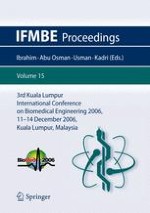2007 | OriginalPaper | Buchkapitel
Degradation of Magnesium Alloys in Biological Solutions and Reduced Phenotypic Expression of Endothelial Cell Grown on These Alloys
verfasst von : S. K. Lu, H. I. Yeh, T. Y. Tian, W. H. Lee
Erschienen in: 3rd Kuala Lumpur International Conference on Biomedical Engineering 2006
Verlag: Springer Berlin Heidelberg
Aktivieren Sie unsere intelligente Suche, um passende Fachinhalte oder Patente zu finden.
Wählen Sie Textabschnitte aus um mit Künstlicher Intelligenz passenden Patente zu finden. powered by
Markieren Sie Textabschnitte, um KI-gestützt weitere passende Inhalte zu finden. powered by
Generally, inflammatory response to the metal stents contributes to the formation of in-stent restenosis. Howerver, recent development of biodegradable stents made of magnesium alloys has a potential to overcome this drawback. Nevertheless, the degradation profile of such stents and the influence on the endothelial cells remained unclear.
In this study, the flat magnesium alloyed sheets cut by wire electrical discharge machine were immersed in distill water or culture medium. In addition, human aortic endothelial cells (HAEC) were seeded (800 cells/mm
2
) onto various magnesium alloyed sheets, including Mg-Al-Zn alloys (AZ31, AZ91) and Mg-Al-Mn alloy (AM60). Cells seeded onto tissue culture treated polystyrene dish coated with gelatin were used as controls. Forty-eight hours later, the cells were examined by immunofluorescence microscopy.
The results were shown that content of Mg
2+
within 15 weeks gradually increased to more than 40 mg/dL in the culture medium, but remained less than 10 mg/dL in the water. For all magnesium groups the cellularity at 48 hours was less than 60% of that of the controls (p<0.01). Comparison among the magnesium alloyed groups showed that both AZ31 and AM60 have lower values of cellularity, compared to the AZ91 (AZ31: 164 cells/mm
2
; AM60: 318 cells/mm
2
; AZ91: 442 cells/mm
2
; AZ91 vs either AZ31 or AM60, both p<0.05). Immunfluorescence microscopy showed that cells grown on such magnesium metals expressed less amounts of Von Willebrand factor (VWF), connexin43 (Cx43) gap junctions, and endothelial nitric oxide synthase (eNOS).
The conclusion suggested that degradation of magnesium alloys are enhanced in culture medium, in which HAEC’s had a retarded growth and protein expression profile grown on the metal. Otherwise, it also suggested that strategies to improve the biocompatibility of stents made of magnesium alloy are necessary.
